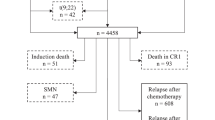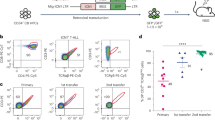Abstract
Antigen receptor gene rearrangements are applied for the PCR-based minimal residual disease (MRD) detection in acute lymphoblastic leukemia (ALL). It is known that ongoing rearrangements result in subclone formation, and that the relapsing subclone(s) can contain antigen receptor rearrangement(s) that differ from the rearrangements found in the major clone(s) at diagnosis. However, the mechanism leading to this so-called clonal evolution is not known, particularly at which time point in the disease the relapsing subclone obtains its (relative) therapy resistance. To obtain insight in clonal evolution, we followed the kinetics of several subclones in three oligoclonal ALL patients during induction therapy. Clone-specific nested PCR for immunoglobulin heavy chain or T cell receptor δ gene rearrangements were performed in limiting dilution assays on bone marrow samples taken at diagnosis, at the end of induction therapy and at possible relapse in three children with oligoclonal B-precursor ALL. We demonstrated that in all three patients the subclones were behaving differently in response to therapy. Moreover, in the two patients who relapsed, the clones that grew out during relapse showed the slowest regression or even evoluated during induction therapy and the clones that were not present at relapse showed good response to induction therapy. These results support the hypothesis that at least in some patients already at diagnosis or in the very first weeks, subclones have important differences in respect to resistance. Hence, these data give experimental evidence for the need to develop, during the first months after diagnosis, quantitative PCR assays for at least two different Ig/TCR gene rearrangement targets for every ALL patient.
This is a preview of subscription content, access via your institution
Access options
Subscribe to this journal
Receive 12 print issues and online access
$259.00 per year
only $21.58 per issue
Buy this article
- Purchase on SpringerLink
- Instant access to full article PDF
Prices may be subject to local taxes which are calculated during checkout

Similar content being viewed by others
References
Beishuizen A, Hahlen K, Hagemijer A, Verhoeven MA, Hooijkaas H, Adriaansen HJ, Wolvers Tettero IL, van Wering ER, Van Dongen JJ . Multiple rearranged immunoglobulin genes in childhood acute lymphoblastic leukemia of precursor B-cell origin Leukemia 1991 5: 657–667
Steward CG, Goulden NJ, Katz F, Baines D, Martin PG, Langlands K, Potter MN, Chessels JM, Oakhill A . A polymerase chain reaction study of the stability of Ig heavy chain and T-cell receptor delta gene rearrangements between presentation and relapse of childhood B-lineage acute lymphoblastic leukemia Blood 1994 83: 1355–1362
Beishuizen A, Verhoeven MA, van Wering ER, Hahlen K, Hooijkaas H, van Dongen JJ . Analysis of Ig and T-cell receptor genes in 40 childhood acute lymphoblastic leukemias at diagnosis and subsequent relapse. Implications for the detection of minimal residual disease by polymerase chain reaction analysis Blood 1994 83: 2238–2247
Ghali DW, Panzer S, Fischer S, Argyriou-Tirita A, Haas OA, Kovar H, Gadner H, Panzer-Grumayer ER . Heterogeneity of the T-cell receptor delta gene indicating subclone formation in acute precursor B-cell leukemias Blood 1995 85: 2795–2801
Steenbergen EJ, Verhagen OJ, van Leeuwen EF, van den Berg H, von dem Borne AEGKr, van der Schoot CE . Frequent ongoing T-cell receptor rearrangements in childhood B-precursor ALL: implications for monitoring minimal residual disease Blood 1995 86: 692–702
Steenbergen EJ, Verhagen OJ, van Leeuwen EF, van den Berg H, Behrendt H, Slater RM, von dem Borne AEG Kr, van der Schoot CE . Prolonged persistence of PCR-detectable minimal residual disease after diagnosis or first relapse predicts poor outcome in childhood B-precursor acute lymphoblastic leukemia Leukemia 1995 9: 1726–1734
Steenbergen EJ, Verhagen OJ, van den Berg H, van Leeuwen EF, Behrendt H, Slater RR, von dem Borne AEG Kr, van der Schoot CE . Rearrangement status of the malignant cell determines type of secondary IgH rearrangement (V-replacement or V to DJ joining) in childhood B-precursor acute lymphoblastic leukemia Leukemia 1997 11: 1258–1265
Szczepanski AJ, Beishuizen A, Pongers-Willemse MJ, Hahlen K, Van Wering ER, Wijkhuis J, Tibbe GJ, De Bruijn MA, van Dongen JJ . Cross lineage T-cell receptor gene rearrangements occur in more than ninety percent of childhood B-precursor acute lymphoblastic leukemias: alternative PCR targets for detection of minimal residual disease Leukemia 1999 13: 196–205
Steenbergen EJ, Verhagen OJ, Nibbering CP, van den Berg H, van Leeuwen EF, Behrendt H, von dem Borne AEGKr, van der Schoot CE . Clonal evolution of immunoglobulin heavy chain rearrangements in childhood B-precursor acute lymphoblastic leukemia after engraftment in SCID mice Leukemia 1996 10: 1471–1478
van den Berg H, Vet R, den Ouden E, Behrendt H . Significance of lymphoblasts in cerebrospinal fluid in newly diagnosed pediatric acute lymphoblastic malignancies with bone marrow involvement: possible benefit of dexamethasone Med Pediatr Oncol 1995 25: 22–27
Verhagen OJ, Wijkhuijs AJ, van der Sluijs-Gelling AJ, Szczepanski T, van der Linden-Schrever BE, Pongers-Willemse MJ, van Wering ER, van Dongen JJ, van der Schoot CE . Suitable DNA isolation method for the detection of minimal residual disease by PCR techniques Leukemia 1999 13: 1298–1299
Takahashi N, Nakai N, Honjo T . Cloning of human immunoglobulin δ gene and comparison with mouse δ gene Nucleic Acids Res 1980 8: 5983–5991
Baer R, Boehm T, Yssel H, Rabbits TH . Complex rearrangements within the human Jδ-Cδ/Jαδ-Cα locus and aberrant recombination between Jα segments EMBO J 1988 7: 1661–1668
Deane M, Norton JD . Immunoglobulin heavy chain variable region family usage is independent of tumor cell phenotype in human B lineage leukemias Eur J Immunol 1990 20: 2209–2217
Steenbergen EJ, Verhagen OJ, van Leeuwen EF, van den Berg H, Behrendt H, von dem Borne AE, van der Schoot CE . IGH/TCR delta PCR oligonucleotide liquid hybridization, a fast and sensitive assay for monitoring minimal residual disease in childhood B-precursor ALL Leukemia 1995 9: 216–222
De Haas M, Kleijer M, Van Zwieten R, Roos D, von dem Borne AEGKr . Neutrophil FcγRIIIb deficiency, nature and clinical consequences: a study of 21 donors from 14 families Blood 1995 85: 2403–2413
Sykes PJ, Neoh SH, Brisco MJ, Hughes E, Condon J, Morley AA . Quantitation of targets for PCR by use of limiting dilution Biotechniques 1992 13: 444–449
Ouspenskaia MV, Johnston DA, Roberts WM, Estrov Z, Zipf Th . Accurate quantitation of residual B-precursor acute lymphoblastic leukemia by limiting dilution and a PCR-based detection system: a description of the method and the principles involved Leukemia 1995 9: 321–328
Taswell C . Limiting dilution assays for determination of immunocompetent cell frequencies J Immunol 1981 126: 1614–1619
Fazekas de St Groth S . The evaluation of limiting dilution assays J Immunol Methods 1982 49: R11-R23
Strijbosch LWG, Does RJMM, Buurman WA . Computer aided design and evaluation of limiting and serial dilutions Int J Biomed Comput 1988 23: 279–290
Küppers R, Zhao M, Hansman M-L, Rajewski K . Tracing B-cell development in human germinal centres by molecular analysis of single cells picked from histological sections EMBO J 1993 12: 4955–4967
Brisco MJ, Condon J, Hughes E, Neoh SH, Sykes PJ, Seshadri R, Toogood I, Waters K, Tauro G, Ekert H, Morley AA . Outcome prediction in childhood acute lymphoblastic leukemia by molecular quantification of residual disease at the end of induction Lancet 1994 343: 169–199
Cavé H, Guidal C, Rohrlich P, Delfau MH, Broyart A, Lescoeur B, Rahimy C, Fennetau O, Monplaisir N, d'Auriol L . Prospective monitoring and quantification of residual blasts in childhood acute lymphoblastic leukemia by polymerase chain reaction study of δ and γ T-cell receptor genes Blood 1994 83: 1892–1902
Dibenedetto SP, Lo Nigro L, Mayer SP, Rovera G, Schiliro G . Detectable molecular residual disease at the beginning of maintenance therapy indicates poor outcome in children with T-cell acute lymphoblastic leukemia Blood 1997 90: 1226–1232
Jacquy C, Delepaut B, Van Daele S, Vaerman JL, Zenebergh A, Brichard B, Vermylen C, Cornu G, Martiat P . A prospective study of minimal residual disease in childhood B-lineage acute lymphoblastic leukemia: MRD level at the end of induction is a strong predictive factor of relapse Br J Haematol 1997 98: 140–146
Foroni L, Coyle LA, Papaioannou M, Yaxley JC, Sinclair MF, Chim JS, Cannell P, Secker-Walker LM, Mehta AB, Prentice HG, Hoffbrand AV . Molecular detection of minimal residual disease in adult and childhood acute lymphoblastic leukemia reveals differences in treatment response Leukemia 1997 11: 1732–1741
Goulden NJ, Knechtli CJ, Carland RJ, Langlands K, Hancock JP, Potter MN, Steward CG, Oackhill A . Minimal residual disease analysis for the prediction of relapse in children with standard-risk acute lymphoblastic leukemia Br J Haematol 1998 1: 235–244
Cavé H, van der Werff ten Bosch J, Suciu S, Guidal C, Waterkeyn C, Otten J, Bakkus M, Thielemans K, Grandchamp B, Vilmer E . Clinical significance of minimal residual disease in childhood acute lymphoblastic leukemia New Engl J Med 1998 339: 591–598
van Dongen JJM, Seriu T, Panzer-Grumayer ER, Biondi A, Pongers-Willemse MJ, Corral L, Stolz F, Schrappe M, Masera G, Kamps WA, Gadner H, van Wering ER, Ludwig WD, Basso G, de Bruijn MAC, Cazzaniga G, Hettinger K, van der Does-van den Berg A, Hop WCJ, Riehm H, Bartram CR . Prognostic value of minimal residual disease in acute lymphoblastic leukemia in childhood Lancet 1998 352: 1731–1738
Steenbergen EJ, Verhagen OJHM, van Leeuwen EF, von dem Borne AEGKr, van der Schoot CE . Distinct ongoing Ig heavy chain rearrangement processes in childhood B-precursor acute lymphoblastic leukemia Blood 1993 82: 581–589
Green E, McConville CM, Powell JE, Mann JR, Darbyshire PJ, Taylor AMR, Stankovi T . Clonal diversity of Ig and T cell-receptor gene rearrangements identifies a subset of childhood B-precursor acute lymphoblastic leukemia with increased risk of relapse Blood 1998 92: 952–958
Pongers-Willemse MJ, Verhagen OJ, Tibbe GJ, Wijkhuijs AJ, de Haas V, Roovers E, van der Schoot CE, van Dongen JJ . Real-time quantitative PCR for the detection of minimal residual disease in acute lymphoblastic leukemia using junctional region specific TaqMan probes Leukemia 1998 12: 2006–2014
Acknowledgements
This work was supported by the SKK (grant 96.02). We thank Prof Dr JJM van Dongen and Prof Dr D Roos for critical reading of the manuscript.
Author information
Authors and Affiliations
Rights and permissions
About this article
Cite this article
de Haas, V., Verhagen, O., von dem Borne, A. et al. Quantification of minimal residual disease in children with oligoclonal B-precursor acute lymphoblastic leukemia indicates that the clones that grow out during relapse already have the slowest rate of reduction during induction therapy. Leukemia 15, 134–140 (2001). https://doi.org/10.1038/sj.leu.2401970
Received:
Accepted:
Published:
Issue date:
DOI: https://doi.org/10.1038/sj.leu.2401970
Keywords
This article is cited by
-
Leukaemia: a model metastatic disease
Nature Reviews Cancer (2021)
-
IgH gene rearrangement by PCR as an adjunct to flow cytometric analysis for the detection of minimal residual disease in patients with B lymphoblastic leukemia
Journal of Hematopathology (2020)
-
Standardized next-generation sequencing of immunoglobulin and T-cell receptor gene recombinations for MRD marker identification in acute lymphoblastic leukaemia; a EuroClonality-NGS validation study
Leukemia (2019)
-
Minimal residual disease in acute lymphoblastic leukemia: optimal methods and clinical relevance, pitfalls and recent approaches
Medical Oncology (2014)
-
Improved flow cytometric detection of minimal residual disease in childhood acute lymphoblastic leukemia
Leukemia (2013)



